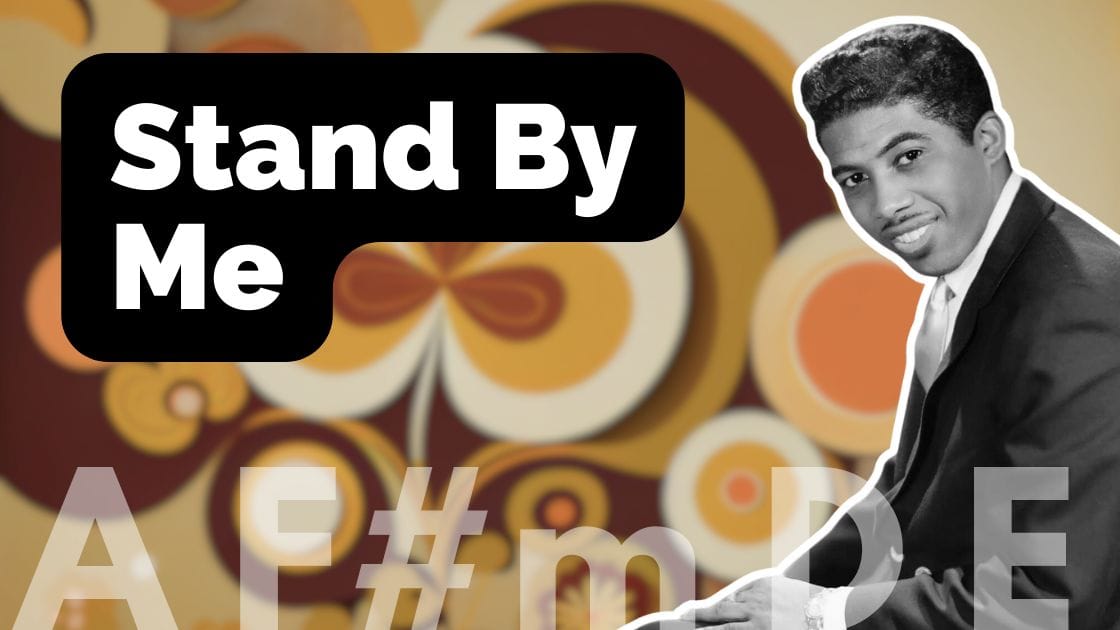The Musical Magic of “Stand by Me”

“Stand by Me,” originally performed by Ben E. King, is a timeless classic that has resonated with audiences for decades. Its enduring appeal lies not only in its heartfelt lyrics but also in its deceptively simple yet powerful musical composition. In this blog post, we’ll look at the music theory behind this iconic song, exploring how its structure, harmony, and melody contribute to its emotional impact.
The Simplicity of the Song Form
At first glance, “Stand by Me” follows a straightforward song form that’s common in many pop and soul songs. However, it distinguishes itself through its consistent use of the same chord progression throughout the entire song—both in the verses and the choruses. This unchanging harmonic foundation creates a stable backdrop that allows the lyrics and melody to take center stage.
Song Structure Breakdown:
• Intro: 8 bars (bass and percussion)
• Verse 1: 16 bars
• Chorus 1: 8 bars
• Verse 2: 16 bars
• Chorus 2: 8 bars
• Instrumental Interlude: 16 bars (featuring strings)
• Chorus 3: 16 bars (fading out)
Despite the repetition, the song remains engaging due to subtle changes in instrumentation and the emotional delivery of the vocals. The introduction of strings during the instrumental interlude adds a new texture without altering the fundamental chord progression.
The Iconic Chord Progression
The song is anchored by a repetitive chord progression in the key of A major:
1. A Major (I)
2. F# Minor (vi)
3. D Major (IV)
4. E Major (V)
5. A Major (I)
This progression is one of the most commonly used in popular music, often referred to as the I–vi–IV–V progression. It creates a sense of familiarity and comfort for the listener.
Harmonic Analysis
• Tonic (I) – A Major: Serves as the home base or point of rest.
• Submediant (vi) – F# Minor: Introduces a slight departure while remaining harmonically close to the tonic.
• Subdominant (IV) – D Major: Adds a gentle lift, moving away from the tonic but not creating significant tension.
• Dominant (V) – E Major: Builds tension that yearns for resolution back to the tonic.
• Return to Tonic (I) – A Major: Provides the satisfying resolution that completes the harmonic journey.
This cyclical movement from stability to slight tension and back to stability mirrors a storytelling arc, giving the song an emotional resonance that listeners subconsciously feel.
The Power of the Ostinato Bass Line
A defining feature of “Stand by Me” is its ostinato bass line—a repeating musical phrase that persists throughout the song. This bass line not only grounds the harmonic progression but also interacts intricately with the melody and rhythm.
Melody and Bass Interaction
Interestingly, the melody at the beginning mirrors the bass line, creating a cohesive musical motif. This mirroring hooks the listener and reinforces the song’s central themes both musically and lyrically.
Rhythmic Elements and Groove
The rhythmic structure plays a crucial role in the song’s appeal. The interplay between the bass and percussion instruments, like the cabasa and triangle, creates a groove that’s both relaxing and engaging.
• Drums and Percussion: Emphasize the off-beats (the “two” and “four” in a 4/4 measure), contributing to the song’s laid-back feel.
• Bass: Leaves space at strategic moments, allowing percussion accents to shine through.
This rhythmic interplay adds layers to the song without overwhelming the listener, maintaining the focus on the vocals and lyrics.
Melodic Use of the Sixth Scale Degree
One of the song’s subtle yet impactful techniques is its use of the sixth scale degree in the melody. Instead of landing on more stable chord tones like the root, third, or fifth, the melody frequently targets the sixth, adding a touch of emotional ambiguity.
• Emotional Effect: The sixth scale degree introduces a note that’s not as harmonically stable, creating a sense of longing or unresolved emotion.
• Pause and Emphasis: The melody often holds on this note during pauses, allowing the listener to feel its impact before the progression continues.
This choice enhances the emotional depth of the song, making the plea of “Stand by me” feel more poignant.
Allowing Lyrics to Shine Through Simplicity
The repetitive nature of the chord progression and the sparse arrangement serve a deliberate purpose—they allow the lyrics to take center stage. By not overcomplicating the musical backdrop, the song ensures that the listener’s attention remains on the heartfelt message.
• Instrumentation: Minimalistic, featuring essential elements that support rather than overshadow the vocals.
• Dynamics: Subtle changes in intensity and the introduction of new instruments (like strings) add variety without disrupting the song’s continuity.
Conclusion
“Stand by Me” exemplifies how simplicity in music can lead to profound emotional connections. Through its stable yet engaging chord progression, clever melodic choices, and rhythmic groove, the song creates a timeless appeal that continues to resonate with listeners. Understanding the music theory behind it not only deepens our appreciation but also highlights the craftsmanship involved in creating such a lasting piece of art.
Whether you’re a musician, a music enthusiast, or someone who simply loves this classic tune, exploring its musical foundations reveals the intricate balance between simplicity and emotional depth that makes “Stand by Me” a masterpiece.